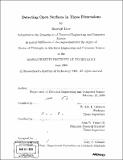Detecting open surfaces in three dimensions
Author(s)
Bose, Biswajit, 1981-
DownloadFull printable version (40.74Mb)
Alternative title
Detecting open surfaces in 3 dimensions
Detecting open surfaces in 3D
Other Contributors
Massachusetts Institute of Technology. Dept. of Electrical Engineering and Computer Science.
Advisor
W. Eric L. Grimson and John W. Fisher, III.
Terms of use
Metadata
Show full item recordAbstract
We present a novel level-set method for representing and detecting open surfaces embedded in three-dimensional image volumes. Open surfaces are two-dimensional manifolds with a one-dimensional boundary lying within a three-dimensional volume. Distinct portions of a closed surface can be modeled as open surfaces, as can very thin volumes with negligible thickness. To detect open surfaces, we propose an interface likelihood model that captures the image appearance along a profile normal to the open surface. This allows statistical modeling of more complex surface-appearance characteristics than just voxel intensities or gradients. Appearance models of the surface are used in the level-set framework in two ways: firstly, to evolve the open surface in the normal direction for the purpose of detecting the location and shape of the surface, and secondly, to evolve the boundary of the open surface in a direction tangential to the surface in order to delineate the extent of the surface. We show that our models are well suited to detecting structures of interest in three-dimensional medical and geological images, and demonstrate their utility on challenging structural magnetic resonance (MR) datasets and seismic-reflection volumes.
Description
Thesis (Ph. D.)--Massachusetts Institute of Technology, Dept. of Electrical Engineering and Computer Science, 2009. Cataloged from PDF version of thesis. Includes bibliographical references (p. 99-104).
Date issued
2009Department
Massachusetts Institute of Technology. Department of Electrical Engineering and Computer SciencePublisher
Massachusetts Institute of Technology
Keywords
Electrical Engineering and Computer Science.